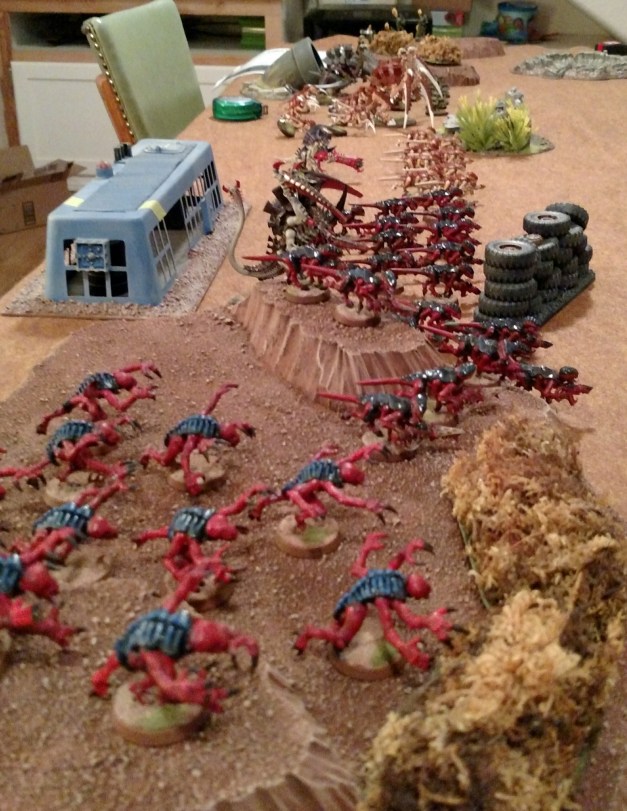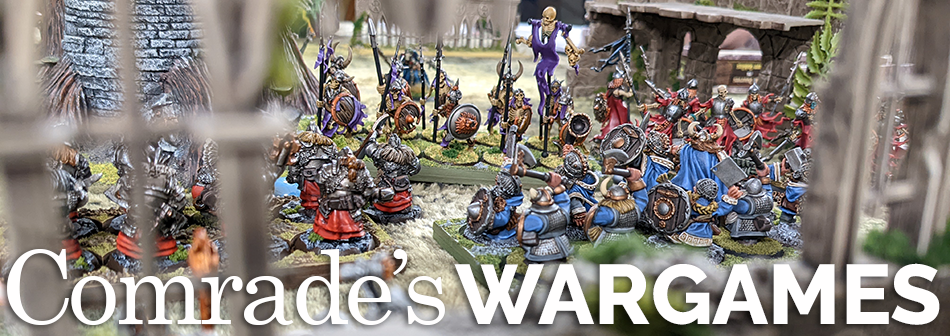
We got in our first proper game of Warhammer 40,000 last weekend, and it was a doozy — both in terms of the game itself, as well as the ramifications for the Caluphel storyline.
The Story So Far…
The game took place immediately after the events in the Archeotech Catacombs. The Tau had withdrawn from the tunnels, having paid a horrific price for whatever ancient secrets they retrieved, and had linked up with the Imperial defenders who were at that very moment fortifying Outpost Omicron against further attack.
Thus a cautious alliance was struck between the Tau and the Imperials (a platoon of Guardsmen along with a few squads of Salamanders Space Marines). And not a moment too soon, as both factions knew that doom was about to come boiling up out of the silent tunnels.

The Tyranids, long dormant in the archeotech catacombs, had been unleashed on Outpost Omicron. A desperate last stand by the defenders might slow them down and allow scouts to alert the rest of the disparate Imperial factions on the planet’s surface…
Game Setup
In game terms, we were playing a meatgrinder scenario with roughly 50 Power Level per side. That didn’t leave the Imperial Guard with enough points to take a lot of tanks, but that’s OK as this was primarily a learning game so we could put 8th edition through its paces.
The Tau, however, brought some heavy support in the form of Paul’s newly painted Riptide. As you can see from the photos, this thing is enormous! It was hard to get it in the frame and maintain the battlefield illusion (no one wants to see my curtains or bookshelf when imagining the grim darkness of the far future).

In any case, Paul had worked hard for many weeks on this beauty, and dammit, we were going to get it onto the battlefield one way or another!
Let’s Play!
And with that, we were off. Our goal here was to play a “proper” game of 40k. We had rulebooks, indices, tape measures and dice … lots and lots of dice. Here’s a look at the swarm…

The meatgrinder scenario included one very important rule: attacking Tyranid squads that were destroyed had the ability to “respawn” back in the Tyranid deployment area, thus approximating an “endless wave” assault by the foul xenos.
Paul and I (playing the Tyranids) enjoyed this rule immensely, as it allowed us to shrug off the massive losses that our bugs suffered as they raced across the battlefield. “Don’t worry, they’ll be back,” was a common refrain as we removed handfuls of gaunts and genestealers.
Anyway, the Tyranids took the first turn, with most squads advancing forward. We found very little in the 40k rulebook that addressed terrain and movement penalties. In a way, that’s OK — after all, the movement rates for various units can be easily understood as being a “tactical” move distance that accounts for cautious movement through terrain and such. But we sort of expected various detailed terrain penalties, given that they are quite common in other wargames.

The bugs got off a few shots, as well as a psychic power or two (leaving the Imperials to bemoan their lack of psychic support). Then the Imperials and Tau answered with their own fusillade of firepower. Tyranids were cut down in their dozens, but I just gleefully quipped “They’ll be back” as I scooped them up from the tabletop.
I didn’t get many turn-by-turn photos, so here’s how it all went down. The right flank of the Tyranids crashed into a section of the defensive line held by the Salamanders, and quickly swarmed the few green-armored defenders.
Even as the Space Marines went down, the Imperial Guardsmen behind sandbagged defensive lines peppered the attackers with lasgun and heavy weapon fire. But the Tyranids were too many in number, and the right flank folded and then collapsed.
This skirmish in particular looked rather one-sided, as a Carnifex scaled a watchtower and dealt with the scout squad on top.

Across the table, the Tau shored up the left flank with hyper-accurate gunfire from their Fire Warriors and a veritable firestorm of death from the Riptide. The Tyranid players quickly adjusted and sent both Carnifexes to deal with the Riptide, but both were killed before they could reach the lumbering battlesuit. But … they’ll be back.

The Second Wave
By that point, most of the Tyranids’ left flank had been eviscerated by the Tau. In a series of spectacular dice rolls, virtually all of the attackers respawned in the Tyranid deployment zone and began the grim march forward once again. The second wave was approaching…

At this point we realized why the meatgrinder scenario allowed the defender to win by having even one unit left alive at the end of the game. The sense of inevitability surrounding the respawn rules meant that the defenders were doomed, one way or another.
With the second wave now reaching the beleaguered Tau and mopping up the last desperate Imperials, it seemed that the Tyranids had all the momentum. Long-ranged firepower from the Carnifexes severely damaged the Riptide battle suit. Fast-moving genestealers crashed into the Fire Warriors, slaughtering them indiscriminately.


Ultimately the game ended after turn 5, and the Tau/Imperial alliance managed to hold out for a minor victory. They still had a couple cohesive units on the battlefield, even though the Tyranids were by that point rampaging through their defensive lines. Another turn or two would have probably sealed their doom.

A Pyrrhic Victory
In any event, the game narrative painted a grim picture: the Imperial garrison at Outpost Omicron had been slaughtered almost to a man. The Tau, already mauled after their encounter in the catacombs, had barely escaped the battlefield. Control of Outpost Omicron is seriously in doubt, as the retreating units sent back frantic, fragmentary reports of ramparts and barracks overrun by swarming bugs.
We’ll see what the future holds for this important strategic location on Caluphel…stay tuned!



Sweet set up and excellent batrep! What are your thoughts on 8th edition gameplay and rules after playing multiple game sessions?
LikeLiked by 1 person
Very cool. I love last-stand scenarios. I’d also be interested in hearing more of your club’s thoughts on 8th edition.
LikeLiked by 1 person
Thanks for the questions guys. Here are a few thought bubbles:
–We really liked the “Power Level” system for quickly throwing together armies. Basically this is like a not-so-granular points system…each unit in an army has a “Power Level” number (like 5 for a Chaos Space Marine squad, or 19 for a Land Raider) that roughly approximates its effectiveness on the battlefield for all possible weapon loadouts and configurations. There is no additional customization. Within each unit, you can select a variety of wargear, but the Power Level never changes. This makes it incredibly easy to build army lists without having to tally up all the fiddly wargear and options. It’s also a super keen way to play WYSIWYG — just add up the Power Levels for each squad and then play them exactly as armed.
–Vehicle rules have totally changed. Now they’re treated as very large figures, with the same stats and the same basic mechanics. No armor or facing or anything like that. This really streamlines gameplay and makes it much easier to intuitively understand the impact of vehicles in the game.
–Cover is really simplified to the point where it’s not satisfying to me. There is 1 level of cover (called “cover” in the book, haha) and you either get it or you don’t. I can see my group houseruling at least a couple more levels of cover to represent heavy fortifications and buildings. It’s almost like GW doesn’t really want cover to matter, and just wants armies to march toward each other rolling dice for the entire game.
–Some weapons do multiple damage for each unsaved wound. This adds another step in the combat process (roll to hit/roll to wound/roll to save/deal damage) but it also adds another level of granularity to the weapons (and let’s face it, that’s why we play sci-fi wargames … for the cool guns!).
–Deep Strike has totally changed. It’s no longer random … units arrive exactly when and where you want them to arrive, no deviation. BUT … they must be placed 9 inches away from the closest enemy, which makes it highly unlikely that the deep striking unit will be able to charge into melee after arriving via deep strike. So basically deep strike has changed into an ambush ability rather than a melee ability. Not a big deal but just an observation.
–The rulebook dedicated a lot of space to many different scenarios, each with their own nifty rules. In addition to using them as written, I could easily see my group cobbling together custom scenarios using various rules plucked from many different scenarios. In general it seems like this edition of 40k has put a priority on scenario-based play, rather than the typical kill-em-all meatgrinder that typifies most 40k games.
LikeLike